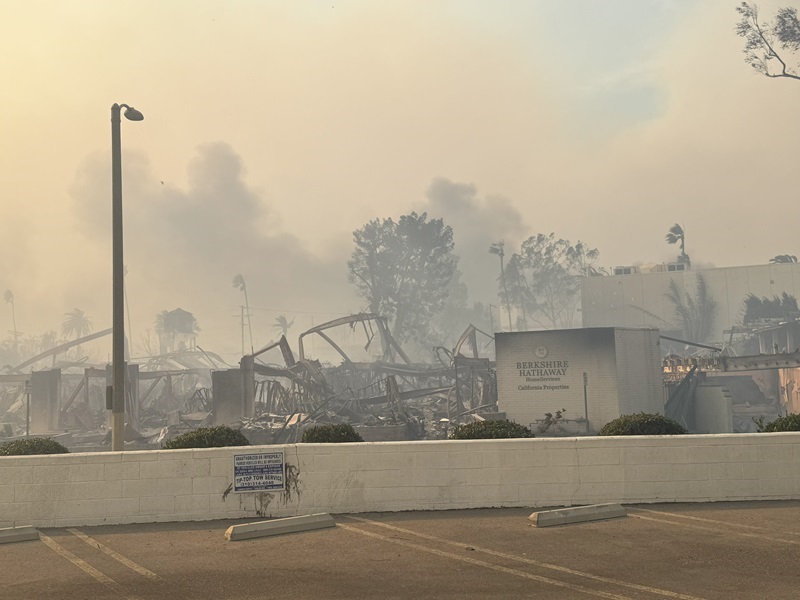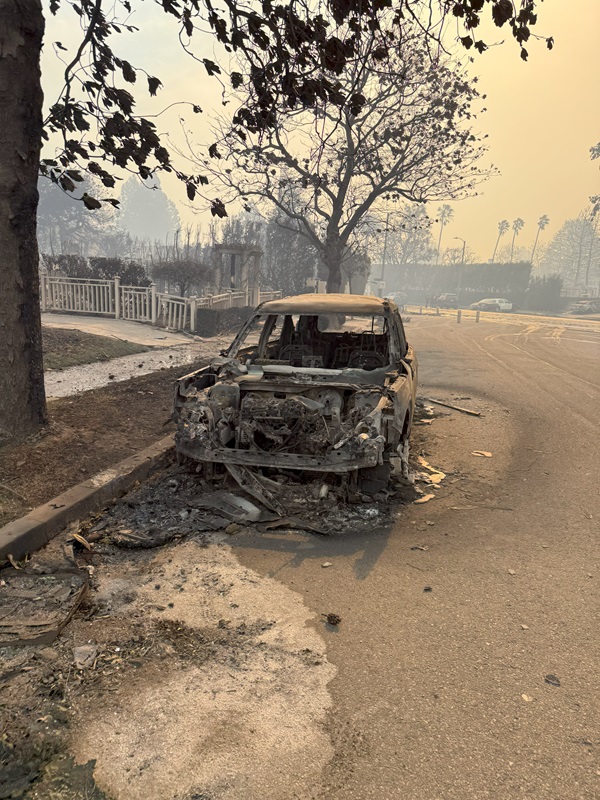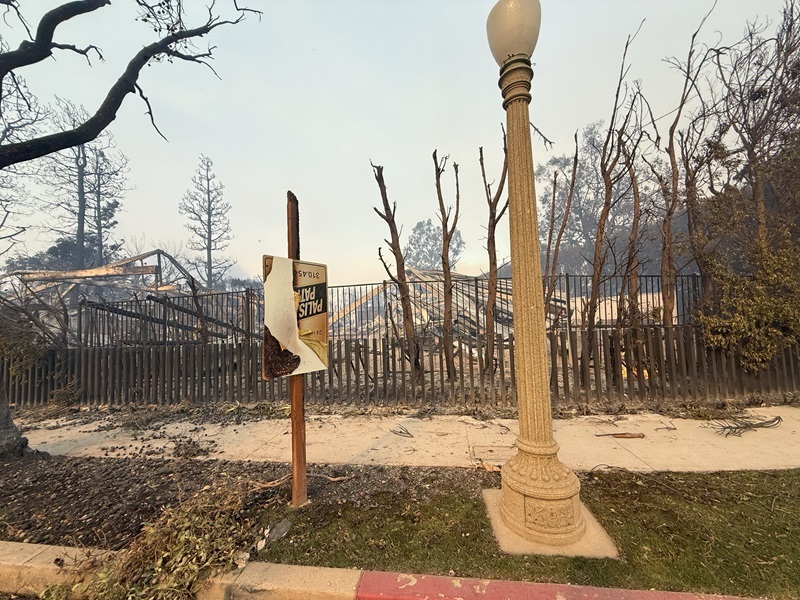Photo by Anthony Marguleas
With few breaks between the gusty Santa Ana winds, firefighting resources pushed to their limits, and arson suspects growing in number by the day, the flames in California this year have been near impossible to stamp out.
Portions of the Los Angeles county landscape lie in rubble as devastating wildfires continue to claim lives and infrastructure—along with the lifelong memories and heirlooms stored in homes that had to be vacated with little to no warming.

Photo by Anthony Marguleas
The two major fires—Palisades and Eaton—ignited January 7, per CAL Fire, destroying 15,467 structures (including residential homes) and damaging 1,852 buildings so far. The Palisades fire has stretched out across 23,713 acres—currently 59% contained at press time—while the Eaton event has burned through 14,021 acres (87% contained).
In total, 27 people have died as a result, and 12 are injured.
The vast damage is wholly incomprehensible, particularly for those who have lost homes and face the threat of dropped insurance or murky coverage terms. The community, however, has come together in a variety of ways, with the real estate industry playing a key role.
Where to go from here
Real estate broker Anthony Marguleas, founder of California-based Amalfi Estates who has helped over 500 Palisadians with their homes over the past 32 years, saw firsthand the toll these fires have taken. His home is Palisades, his four children went to school there, and now his own property is gone.
Marguleas lived in the Alphabet Streets section of LA, which he says has been the hardest hit of any area of the Palisades. It accounted for 1,231 properties, 99% of which were destroyed.
The Palisades incident covers an area of 43,056 households, while Eaton’s includes 38,608 households. Twenty-five percent of Palisadians are 65 years or older, per Marguleas. Within the areas of the Eaton fire, that number totals 21,956 residents. While older homeowners will most likely not be rebuilding, Marguleas says younger demographics are more likely to return to the area.
“Almost everyone we’ve talked to is looking to rebuild. Now, will that change when they start the process in a year or so? That’s another story,” he tells RISMedia. “But most people below age 60 want to stay. This is such a special town and place.”
Real estate impact
Anthony Luna, CEO of property management company Coastline Equity in Torrance, California, says the wildfires have displaced thousands of families and further strained the area’s housing supply.
“With over 12,000 structures lost, including homes, businesses and schools, residents are grappling with urgent housing needs,” he says. “The tight rental market, alongside already rising rents and limited availability, reflects the severity of the impact, especially in neighborhoods that were already under high demand.”
There’s an immediate need for more resilient housing options, with the company seeing increased inquiries into fire-resistant building materials, defensible space and updated HVAC, attic vents or electrical systems designed to limit fire risks.
While many buyers and renters are looking toward more urban, higher-density options to avoid wildfire prone regions—with increasing remote work opportunities also driving the trend—Luna says the county faces a lot of red tape in permitting to address supply constraints.
Luna predicts a surge in conversations around the following as a result of these latest fires:
- Greater emphasis on fire-resistant construction and retrofitting
- Land use and zoning changes that discourage expansion into the wildland urban interface
- More public-private partnerships to ensure affordable insurance coverage
- Continuing demand for urban core housing as some buyers move away from higher-risk zones
“I had a neighbor who hosted 12 people from Los Angeles in their Newport home last weekend, some looking to move down to Orange County. One of my coworkers had a friend receive four unsolicited offers on their home in Manhattan Beach, 40% – 50% higher than expected.” — Tara Sauerbrey, Director of Bridge Sales, Fidelity Bancorp Funding
“The Los Angeles housing market is grappling with an unimaginable crisis. Over 12,000 homes have been destroyed by wildfires in just one week, leaving a gaping hole in housing supply. As a result, rental prices are soaring—one $4M property saw its rent double from $15,900/month in September to $29,500/month today.” — Russell McDonald, Mortgage Specialist & Licensed Broker, Wymac Capital, Inc.
“I have to think surrounding areas in LA County will be hit the hardest with increased buyer and renter demand. That’s what we saw after the Camp Fire as Chico was inundated with displaced residents. I think the biggest issue is what happens with insurance ahead, and we need time to see any effect. The availability of insurance is a huge issue right now in California real estate. It’s possible some prospective local buyers could grow more sensitive about purchasing in outlying areas with FAIR Plan insurance, but at the same time, people shopping in those areas are already very informed about insurance.” — Ryan Lundquist, Owner, Lundquist Appraisal Company
The insurance quandary

Photo by Anthony Marguleas
Property losses are estimated to be between $35 billion to $45 billion, according to CoreLogic as of January 20.
“The destruction caused by these fires is anticipated to be the most expensive in the state’s history with effects on the insurance industry that will persist into the future,” said Tom Larsen, senior director of CoreLogic Insurance Solutions, in a statement.
Insurance carriers have become more cautious in enacting policies within high-risk areas, leaning on higher insurance premiums or nonrenewals to navigate the increased chance of fire across California, according to Luna. As a result, he’s seen clients seek out coverage on the secondary market at much higher costs.
“As real estate professionals, we encourage clients to explore specialized coverage or state-assisted insurance programs if they cannot access the traditional market,” says Luna. “Thorough documentation and risk mitigation measures—such as using fire-resistant materials, interior inspections twice per year and regularly documented exterior inspections—we can help our clients lower premiums.”
It’s been an especially difficult road for renters, which made up 23% of affected residents in the Palisades region. “Most people are unaware so many Palisadians rented. This is important because renters were severely underinsured ($20 – $30k) for personal contents, and many did not have insurance at all,” says Marguleas.
Dr. Selma Hepp, chief economist at CoreLogic, tells RISMedia that the most immediate impact will likely be a surge in rents as displaced households seek shelter and families prioritize staying in the area so their kids can attend the same school.
“In previous natural disasters of similar magnitude, rent growth tripled from pre-event,” says Hepp. “In terms of mortgages, there is likely to be a surge in mortgage delinquencies as displaced families figure out the status of their home and insurance coverage. Some could be facing unemployment, which is another driver of mortgage delinquencies following a natural disaster.”
California Governor Gavin Newsom recently announced that five major lenders would provide mortgage relief to their customers who are LA firestorm victims, providing up to a 90-day grace period on mortgage payments, 90-day waiver of late fees and 60- to 90-day moratoriums on new foreclosures for property owners whose structures were damaged or destroyed by the LA firestorms.
Seydina Fall, academic program director of the Real Estate and Infrastructure program at Johns Hopkins Carey Business School, says the concept of “inhabitability”—meaning homes that are too risky to live in—will become more prevalent with the rise in wildfire incidents.
The biggest challenge, however, is going to be the lack of supply in terms of insurance carriers that want to remain in the business.
“When you price the risk, it has just gotten too expensive to insure these homes,” says Fall. “The insurance companies know that the repriced risk will result in premiums that are too expensive for the market to bear. State Farm canceled policies last year in the very same area where the fires occurred this year.”
Tools and resources
Aid has come in various formats: federal assistance, local community efforts and real estate companies partnering with organizations or supplying funds through their own charitable arms.
For those impacted, Fall suggests subscribing to a reliable source of information about where to get help, such as the Watch Duty app.
“Also, determine what the government can and cannot do in terms of being an ‘insurer of last resort.’ Lastly, communities need to have a well-organized ‘managed retreat’ plan as part of their urban planning process so that when disasters like this happen, people can relocate seamlessly to safer areas in a cost-efficient way,” he says.
At Coastline Equity, Luna says the company has worked closely with property owners to comply with anti-price gouging laws. Additionally, it has worked with the Apartment Association of Greater Los Angeles to identify available units for families affected by the fires.

Photo by Anthony Marguleas
“Real estate professionals can also facilitate connections with vetted contractors, architects and permitting specialists to ensure a smoother rebuilding process,” says Luna.
Pathways to support:
- Federal Emergency Management Agency (FEMA): Offers grants for temporary housing and some home repairs. Click here.
- U.S. Small Business Administration: Assistance for homeowners, renters, nonprofits and businesses of all sizes affected by the wildfires and straight-line winds in California. Apply here.
- The California Office of Emergency Services: Provides up-to-date information on state-level help. Click here.
- Los Angeles County Disaster Recovery Centers: Cal OES, state agency staff, federal and local partners work to help fire survivors get back on the road to recovery. Click here.
Real estate efforts:
- The National Association of REALTORS®
- The REALTORS® Relief Foundation (RRF): Providing housing-related assistance to disaster-impacted communities through the donations of REALTORS®, state and local associations, and industry partners. Apply here.
- California Association of REALTORS®
- C.A.R. Disaster Relief Fund: Provides grants for REALTORS®, employees of REALTORS® and association staff. Apply here.
-
- Coldwell Banker
-
- Send donations (clothing, food, toiletries, baby and pet supplies) to:
- Beverly Hills: 301 N Canon Dr Ste E., Beverly Hills, CA 90210
- Calabasas: 23647 Calabasas Rd., Calabasas, CA 91302
- Pasadena: 388 S Lake Ave., Pasadena, CA 91101
- Santa Monica: 1608 Montana Ave., Santa Monica, CA 90403
- Sherman Oaks: 15490 Ventura Blvd., Ste 100 Sherman Oaks, CA 91403
- Send donations (clothing, food, toiletries, baby and pet supplies) to:
-
- Anywhere Real Estate
- Anywhere Disaster Relief Fund: Direct assistance to family of employees, franchisees and independent sales agents who have been impacted by the wildfires.
- Anywhere Real Estate
-
- Century 21
- Support displaced pets by donating supplies or providing shelter through Century 21 affiliate and local YMCA in Downey, California.
- Century 21 Lotus: 10220 Lakewood Blvd, Downey, CA 90241
-
- Keller Williams
- KW Cares: KW Cares emergency grants serve the basic health, welfare, housing and transportation needs of Keller Williams associates and their families.
- Keller Williams
“So far, we know that at least a dozen of our agents have lost their homes, and many others are displaced due to evacuation orders,” says Alexia Rodriguez, CEO of KW Cares, Keller Williams’ charitable organization. “KW Cares has opened the emergency grant process for agents needing immediate assistance and is prepared to award larger Catastrophic Hardship Grants to KW Agents as they rebuild their lives after this devastating wildfire.”





